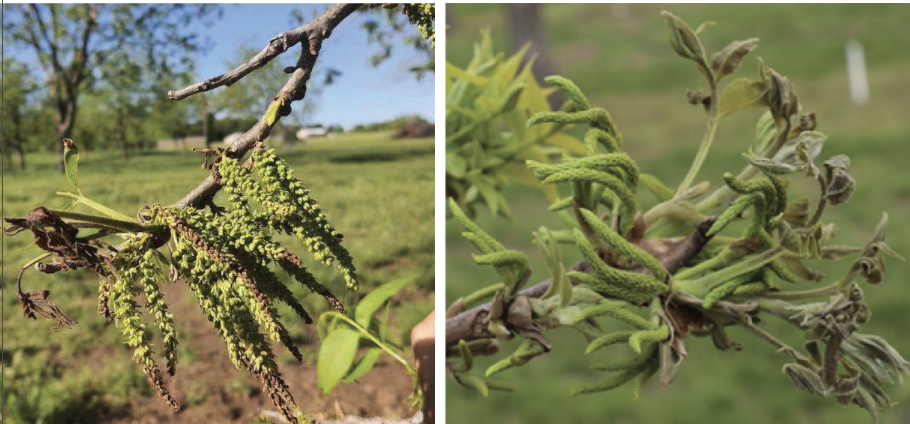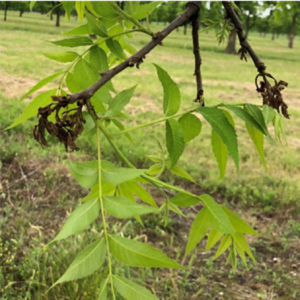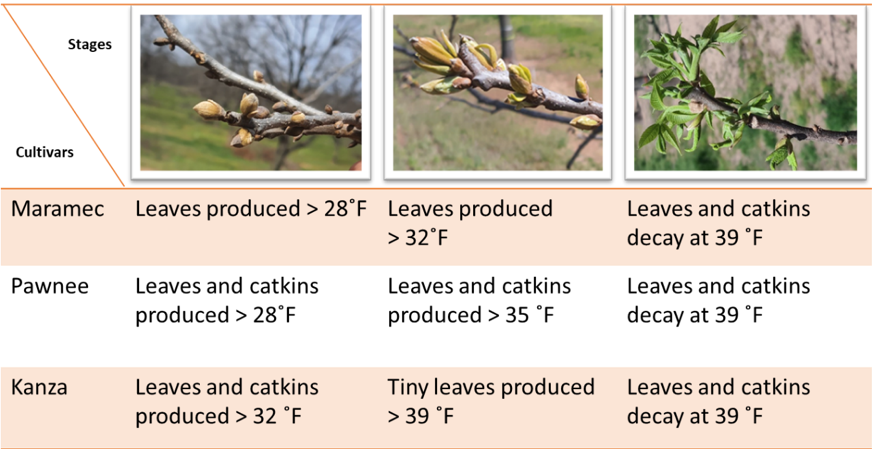Oklahoma’s 2021 spring freeze impact on pecan flowers

Figure 1—Damaged flowers of ‘Pawnee’ (Type 1) on the far left compared to damaged flowers of ‘Kanza’ (Type 2) after the 2021 spring freeze in Oklahoma. (Photo by Lu Zhang)
Do cultivars react differently when exposed to spring freeze?
Pecans exhibit heterodichogamy, meaning there are two different pollination types of pecans. Type 1 (protandrous) includes the cultivars’ Pawnee,’ ‘Hark,’ ‘Peruque,’ ‘Giles,’ and ‘Oconee,’ which produce catkins and mature pollen before the stigma of the female flowers are receptive. Type 2 (protogynous) includes the cultivars’ Kanza,’ ‘Maramec,’ ‘Shawnee,’ ‘Lakota,’ and ‘Colby,’ which produce catkins and mature pollen after the stigma of the female flowers are receptive.
In late April 2021, both ‘Pawnee’ (Type 1) and ‘Kanza’ (Type 2) initiated bloom at the experimental orchard in Perkins, Oklahoma. The difference between producing catkins and pollen before the stigma (Type 1) and after the stigma (Type 2) resulted in severe damage of catkins on ‘Pawnee’ (Type 1) (Fig. 1a) and discoloration of leaves and female flowers on ‘Kanza’ (Type 2) (Fig. 1b).
Field observation of the spring freeze damage confirmed a different story than expected. We had assumed that ‘Pawnee’ (Type 1) would have received less injury as it still hadn’t produced female flowers. The assumption was that Type 1 cultivars, such as Pawnee, would continue to progress normally since the female flowers were not visible yet and, therefore, hadn’t been damaged. However, we were wrong. ‘Pawnee,’ a Type 1 cultivar, did not continue to develop normally after the freeze. Instead, ‘Kanza,’ the Type 2 cultivar we observed, overcame the aborted pistillate flowers by producing secondary shoots and pistillate flowers. However, the secondary flowers were tiny compared to those developed from the primary buds. In contrast, ‘Pawnee’ produced very few secondary buds and female flowers.
Some pecan cultivars have the unique capacity to produce secondary buds that can develop into healthy flowers if the primary buds are impaired; this functions as a fail-safe to guarantee some nut production following adverse conditions. Earlier last year, several growers in Oklahoma sent us pictures of secondary flowers that were smaller than normal (Fig. 2) and worried they wouldn’t be able to mature normally. Previous research reported abnormal flowers developed from secondary buds in some pecan cultivars (e.g., ‘Desirable’) (Wells, 2008). However, many growers with pecan orchards affected by the spring freeze this year were—more or less—still able to harvest a modest crop from their ‘Kanza’ (Type 2) trees.
Based on this experience, we assume that type 2 cultivars with an enhanced ability to produce secondary reproductive shoots like ‘Kanza’ could be more suitable for regions suffering from late spring freezes. Have you observed anything similar to the above phenomenon in your orchard? We welcome the chance to learn more about your story; please send comments to Lu Zhang (luzhang@okstate.edu).
We believe that this behavior in secondary bud production is fascinating, and we wanted to take this opportunity to mention it at this early stage even though there is still much research to conduct before we can come to a definitive conclusion. The research continues on the sproutability of secondary buds among pecan cultivars since this phenomenon varied upon different flower stages present during the spring freeze.
Here we would like to present some of our findings.
We collected shoots from three pecan cultivars—‘Pawnee,’ ‘Kanza,’ and ‘Maramec’—with buds/flowers at two different growth stages: stage 1 – outer bud scale shed stage, and stage 2 -inner bud scale shed stage. The sproutability of secondary buds was observed with a pre-treatment of 21 degrees F for four hours to kill the primary buds.
Our results indicated that the number of branches with secondary buds and the bud/flower stage when primary buds were killed off varied among cultivars. ‘Kanza’ and ‘Pawnee’ have a higher ability to produce secondary buds when primary buds fail in stage 1, while ‘Maramec’ produces more secondary buds in stage 2.
In this preliminary research, we also collected flowers at early bloom (before the stigma is receptive to pollen) and treated the flower with 21 degrees F for four hours; however, the temperature was too cold and killed both primary and secondary buds. Further experiments on secondary buds will be explored and, hopefully, will provide useful information for orchard management or breeding programs.
Does the rootstock play any role in protecting buds from spring freeze?
We observed flower damage and carbohydrate levels of ‘Kanza’ grafted on three different rootstocks’ Giles,’ ‘Colby,’ and ‘Mount’ during the freeze event. On April 21, 2021, flowers of ‘Kanza’ on all these three rootstocks were at initial blooming with young leaves, female flowers, and catkin developed (Fig. 1b). However, ‘Kanza’ flowers on the three rootstocks differed in the degrees of damage. Tree grafted on ‘Mount’ had severely damaged catkins and leaves on a large number of branches, while those grafted on ‘Giles’ had less damage, most of which was seen on the tips of terminal leaves and some terminal buds. These observations revealed that the susceptibility of flowers, even at the same bloom stage, might be influenced by differences in the carbohydrate storage, nutrient and water absorption, and translocation within each rootstock.

Figure 2—Secondary bud growth in ‘Kanza’ after primary bud damage in 2021 spring freeze. (Photo by Lu Zhang)
To better understand this mechanism, we got ahead of the storm and collected shoots of ‘Kanza’ grafted on the three different rootstocks one day before the expected freeze; then, we followed up by collecting shoots again on the same group of trees after the freeze. The purpose was to understand if the trees’ carbohydrate levels could play a role in protecting the flowers.
It is generally agreed that carbohydrates stored in the roots are slowly depleted during the winter and the consumption rate increases in the spring before bud break and flowering. Stored root starch hydrolyzes into monomeric sugars and is delivered to shoots via xylem (wood) sap. Once in the shoot, these sugars are again transformed to starch and stored to support later bud break and bloom.
Our results demonstrated that there was a significant difference in the wood sugar level of ‘Kanza’ grafted on three rootstocks before the freeze event. ‘Kanza’ grafted on ‘Mount’ (60.1 mg/g DW) and ‘Colby’ (58.23 mg/g DW) exhibited significantly higher wood sugar levels than ‘Kanza’ grafted on ‘Giles’ (43.51 mg/g DW). However, after the freeze, the wood sugar of ‘Kanza’ grafted on ‘Giles’ had a significant increase and reached 52.5 mg/g DW, while the wood sugar of ‘Kanza’ grafted on ‘Mount’ and ‘Colby’ dropped to 48 mg/g DW. As mentioned above, flowers from ‘Kanza’ grafted on ‘Giles’ had less damage than flowers collected from ‘Kanza’ grafted on ‘Mount’ and ‘Colby.’
Like wood sugar, the starch level in ‘Kanza’/‘Giles’ is significantly lower than ‘Kanza’/‘Colby’ and ‘Kanza’/‘Mount’ before the freeze, but the starch level increased in ‘Kanza’/‘Giles’ and decreased in the other two rootstocks after.
It seems ‘Kanza’ grafted on ‘Giles’ uses fewer resources, and when the stress occurs, like humans encountering a cold environment, the trees produce more energy to protect themselves. In other words, rootstock regulates carbohydrate allocation, and the regulation ability varies between different rootstocks. Another simple way to explain this phenomenon might be that flowers on ‘Giles’ were at an earlier stage than the two other rootstocks, and less activity translated to more tolerance to freezing, even though we cannot see the difference in appearance. Combined together, the results give a clue that proper rootstock might be a tool to protect buds/flowers from freeze.
What is the critical temperature at which damage is imminent?

Table 1—Critical temperature of the buds/flowers to freeze temperatures at three different stages: outer buds scale split, inner bud scale split, and early bloom in ‘Maramec,’ ‘Pawnee,’ and ‘Kanza.’
When a freeze is coming, many growers become anxious to know if it is the duration or the actual cold temperature that will threaten the flowers and crops. What is the critical temperature? Our team conducted a chamber experiment that collected ‘Pawnee,’ ‘Kanza,’ and ‘Maramec’ shoots with buds/flowers at three different stages: outer buds scale split, inner bud scale split, and early bloom. The shoots were brought back to the lab and treated at five different temperatures (28, 32, 35, and 39 degrees F) for four hours. After the treatment, shoots were maintained in pure water in growth chambers where the temperature and humidity mimicked historical moderate spring conditions. We presented our results (Table 1) in June at the 2021 Annual Convention & Trade Show, Oklahoma Pecan Growers Association in Broken Arrow, Oklahoma. Collected data showed that flowers of ‘Maramec’ were more tolerant to freeze than ‘Pawnee’ and ‘Kanza,’ and were able to produce leaves after a 28-degree freeze at stage 1 and a 32-degree freeze at stage 2.
Compared to ‘Maramec’ and ‘Pawnee,’ ‘Kanza’ is most sensitive to cold temperatures. However, at early bloom, leaves and catkins decayed when the cold treatment was still as high as 39 degrees F. Analysis of stigma structure, which supports pollen reception and hydration, supported the chamber visual observation that stigma had collapsed on the flowers when treated at 39 degrees F for four hours at early bloom stage. This finding reveals that “cold temperature” could be a more accurate term than “spring freeze” in describing the spring temperature issues in pecans. However, it should be noted that the critical temperature tested in the lab may have been higher than the field situation as shoots in experiments were removed from trees, cutting off the shoots’ backup supply of nutrients supplied when still attached to the trees. The critical temperature research in the chamber is intended to provide a reference to the orchard management.
Our current research provided basic information for critical freeze temperatures, the reaction of cultivars and rootstocks to spring freeze, and the potential solution of using secondary buds. We will continue to explore solutions to this issue in pecans, and even though the process may be long and arduous, this information is still an important step forward.

